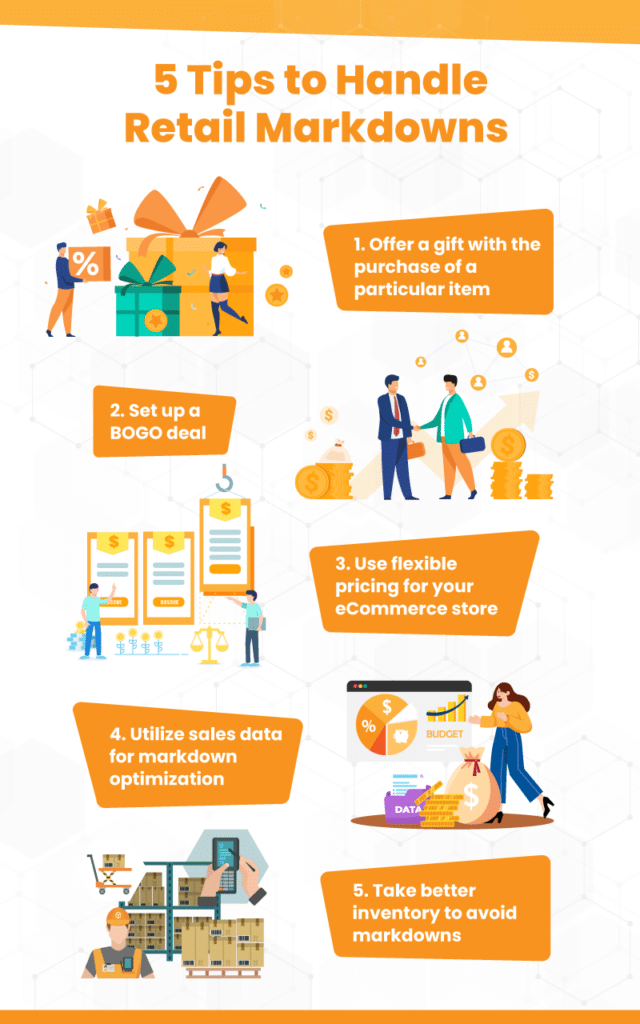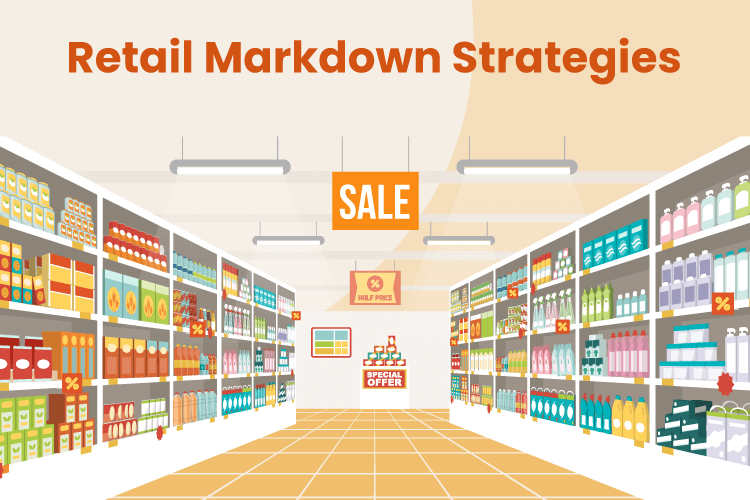Similar to discounts and promotions, retail markdowns entail lowering the price of a given item. But unlike discounts and promotions, markdowns are permanent price changes. They don’t come attached to specific criteria. For instance, college students or senior citizens might qualify for certain discounts. Or stores might run holiday sales. Markdowns, on the other hand, are simply price reductions to encourage more sales of an item.
Most markdowns are the result of products not selling well, so it’s important for retailers to find ways to minimize their losses. Unfortunately, U.S. retailers lose about $300 billion a year to markdowns. In order to not add to that number, businesses need to plan ahead and determine a detailed and consistent policy for store markdowns.

1. Offer a Gift with the Purchase of a Particular Item
Gift-with-purchases improve the customer shopping experience and are a great way to incentivize a purchase. But you can’t simply give away any item. It’s important to calculate the inventory cost of the gift. Figure out the percentage of revenue lost with each gift-with-purchase.
For instance, you’re trying to sell a pair of boots you purchased for $50 at a retail price of $100 for a 100% markup. But you’re offering a pair of wool socks with each purchase. The socks cost you $10, reducing your profit to $40 per sale. The markup is now just 80%. Analyze if this is affordable for your store.
An 80% markup might sound like a lot, but some retailers’ overhead costs require higher markups. Just be sure that your business can afford the loss.
2. Set Up a BOGO Deal
Everybody likes a buy-one-get-one-free deal! Almost all of us have been swayed into purchasing an item just because we get a second one for free. It’s fun and exciting; you feel like you’ve cracked the system.
After all, offering items for free might not have much value for you, but they hold a LOT of value for your customers.
Determine which products you’ll offer for a BOGO deal and set the pricing appropriately. You might set the price slightly higher than it had been before the deal. It’s unlikely to deter your shoppers from making the purchase.
Buy-one-get-one deals can also apply to a number of different items, but they are particularly well-suited for products with a higher markup. Giving away a second will not easily affect your business’s profit margins.
3. Use Flexible Retail Pricing for Your eCommerce Store
Allowing for some wiggle room in your pricing can keep your products more competitive online. Finding ways to compete with Amazon and other eCommerce sites that thrive off cheap prices is crucial.
Price matching is one way of keeping up with the big box e-tailers. Just be careful not to try to compete where you can’t. Going too low on price matching can mean big losses in the long run.
Another way to compete online is to change your prices when the supply elsewhere goes down. For example, say you sell niche items that only a few retailers carry and notice that one or more are sold out. You can raise your prices to match the lessened supply in this situation.
Adding flexibility to your prices is a great way to keep up with the market and maximize your profit without relying on full-scale markdowns.
4. Utilize Sales Data For Markdown Optimization
Retailers should utilize POS sales data for markdown optimization. Analyze historical purchasing patterns to identify products that consistently underperform. You can determine when to introduce markdowns on slow-moving items by tracking inventory turnover rates and seasonal purchase data.
By tracking seasonal patterns and identifying sales peaks and troughs, retailers can strategically time product markdowns to coincide with periods of lower demand. This precision helps clear excess inventory and boost sales.
Retailers can tailor markdown strategies to specific target audiences by segmenting the data based on customer demographics or purchase behavior. Enhancing the effectiveness of your markdowns by making data-driven decisions.
In addition, your retail point of sale analytics will provide figures that help you determine whether your markdowns are actually helping. For example, KORONA POS offers built-in retail KPIs for everything from year-over-year reports to ABC analysis and more.
5. Take Better Inventory to Avoid Markdowns
Most retailers who marked down their prices did so because of mismanaged inventory.
Optimize your ordering. Shelf and storage space are often times a premium for retail business owners. You can’t afford to over-order and have dead stock stuck in your store for months. Doing so will leave you forced to devise ways to move the inventory, usually by marking down the prices. Be preventative and avoid this situation.
Follow trends. Know what products move and what rates. Anticipate seasonal trends by looking at years past. Your ordering will most likely be very different in July than in November. But you must know exactly how it will be different.
Follow your inventory analysis suggestions. Your retail POS system can give you actionable advice on stock and price items. See your real money makers and what might be better off coming off the shelves.
To learn more about how your point of sale can help your retail markdown strategy, call us at KORONA. We’ll show you how to navigate the system so that your inventory is in order and you can avoid having to deal with markdowns altogether!
FAQs: Retail Markdown Strategy
Markdown in retail pricing refers to reducing a product’s original selling price to stimulate sales and move inventory. Retailers often use markdowns to manage excess stock, seasonal items, or slow-selling products. Offering discounts can attract customers and improve overall revenue while maintaining a healthy inventory turnover rate.
An example of a markdown in retail is a clothing store applying a markdown of 30% off on winter coats at the end of the season to encourage customers to buy them before new stock arrives. This way, the store clears the inventory in time for the new season reducing the amount of slow-moving items.
Markdowns benefit a store in several ways. They help clear out excess or slow-moving inventory, freeing up space for new merchandise. Markdowns also attract price-conscious customers and boost sales, which can lead to increased foot traffic and brand loyalty. Finally, strategic markdowns prevent inventory obsolescence and minimize potential losses, ensuring the store remains competitive and financially viable in the long run.













